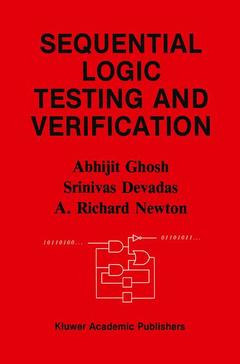Description
Sequential Logic Testing and Verification, Softcover reprint of the original 1st ed. 1992
The Springer International Series in Engineering and Computer Science Series, Vol. 163
Authors: Ghosh Abhijit, Devadas Srinivas, Newton A. Richard
Language: English
Subject for Sequential Logic Testing and Verification:
Keywords
Counter; RTL; VLSI; algorithms; computer; computer-aided design (CAD); integrated circuit; logic; manufacturing; mechanism; stability; tables; testing
158.24 €
In Print (Delivery period: 15 days).
Add to cart
Publication date: 10-2012
214 p. · 15.5x23.5 cm · Paperback
214 p. · 15.5x23.5 cm · Paperback
Description
/li>Contents
/li>
In order to design and build computers that achieve and sustain high performance, it is essential that reliability issues be considered care fully. The problem has several aspects. Certainly, considering reliability implies that an engineer must be able to analyze how design decisions affect the incidence of failure. For instance, in order design reliable inte gritted circuits, it is necessary to analyze how decisions regarding design rules affect the yield, i.e., the percentage of functional chips obtained by the manufacturing process. Of equal importance in producing reliable computers is the detection of failures in its Very Large Scale Integrated (VLSI) circuit components, caused by errors in the design specification, implementation, or manufacturing processes. Design verification involves the checking of the specification of a design for correctness prior to carrying out an implementation. Implementation verification ensures that the manual design or automatic synthesis process is correct, i.e., the mask-level description correctly implements the specification. Manufacture test involves the checking of the complex fabrication process for correctness, i.e., ensuring that there are no manufacturing defects in the integrated circuit. It should be noted that all the above verification mechanisms deal not only with verifying the functionality of the integrated circuit but also its performance.
List of Figures.- List of Tables.- Preface.- Acknowledgements.- 1 Introduction.- 1.1 IC Design Systems.- 1.2 Implementation Verification.- 1.3 Testing.- 1.4 Synthesis For Testability.- 1.5 Outline.- 2 Sequential Test Generation.- 2.1 Preliminaries.- 2.2 Methods for Sequential Test Generation.- 2.3 Test Generation Strategy.- 2.4 Cover Extraction and Combinational ATG.- 2.5 Justification.- 2.6 Initialization of Circuits.- 2.7 State Differentiation.- 2.8 Identification of Redundant Faults.- 2.9 Test Generation Results Using STEED.- 2.10 Conclusions.- 3 Test Generation Using RTL Descriptions.- 3.1 Preliminaries.- 3.2 Previous Work.- 3.3 Global Strategy for Test Generation.- 3.4 State Justification.- 3.5 Indexed Backtracking.- 3.6 Conflict Resolution.- 3.6.1 Assembling the equations.- 3.7 State Differentiation.- 3.8 Test Generation Results Using ELEKTRA.- 3.9 Conclusions.- 4 Sequential Synthesis for Testability.- 4.1 Preliminaries.- 4.2 Previous Work.- 4.3 Theoretical Results.- 4.4 The Synthesis and Test Strategy.- 4.5 Detection of Invalid States.- 4.6 Detection of Equivalent States.- 4.7 Experimental Results.- 4.8 Conclusions.- 5 Verification of Sequential Circuits.- 5.1 Preliminaries.- 5.2 Previous Work.- 5.3 Implicit STG Traversal.- 5.4 Implicit STG Enumeration.- 5.5 Experimental Results.- 5.6 Conclusions.- 6 Symbolic FSM Traversal Methods.- 6.1 Preliminaries.- 6.2 Traversal by Recursive Range Computation.- 6.3 Traversal based on Transition Relations.- 6.4 Depth-First Geometric Chaining.- 6.5 A Mixed Traversal Algorithm.- 6.6 Implementation of Algorithm.- 6.7 Experimental Results.- 6.8 Conclusions.- 7 Conclusions.- 7.1 Test Generation.- 7.2 Synthesis for Testability.- 7.3 Verification.- 7.4 Directions for Future Work.
© 2024 LAVOISIER S.A.S.




